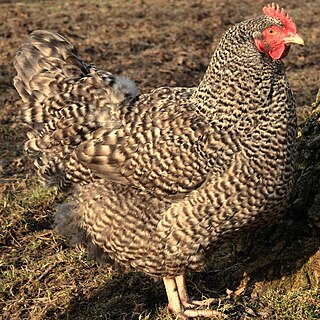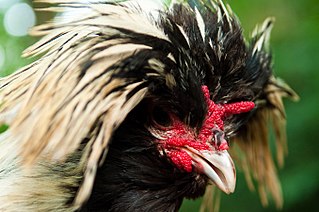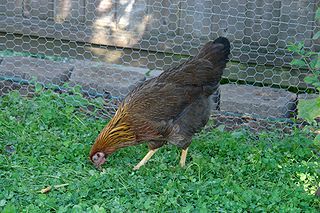 W
WThe Barnevelder is a Dutch breed of domestic chicken. It resulted from cross-breeding between local Dutch chickens and various "Shanghai" birds imported from Asia to Europe in the later part of the nineteenth century; these may have been of Brahma, Cochin or Croad Langshan type. It is named for the town and gemeente (municipality) of Barneveld, in Gelderland in the central Netherlands. The hens are good layers of large brown eggs and, unlike some other breeds, continue to lay well during winter.
 W
WThe Booted Bantam or Dutch Booted Bantam, Dutch: Sabelpoot, is a bantam breed of chicken. Its name is derived from the extravagant feathering on the feet and hock joints, which are called vulture hocks or "sabels" in Dutch. With no large fowl counterpart from which it was miniaturized, the Booted is one of the true bantams. Males usually weigh in at around 850 grams and females 750 grams. American standards dictate a smaller ideal size of 740 grams for males, and 625 for females.
 W
WThe Brabanter is a Dutch breed of crested chicken originating in the historic region of Brabant which straddles Belgium and the Netherlands. It is an ancient breed and is shown in 17th-century paintings. A bantam Brabanter was created in around 1934.
 W
WThe Dutch Bantam is a breed of bantam chicken originating in the Netherlands. It is a true bantam, a naturally small bird with no related large fowl from which it was miniaturized. It is kept mainly for exhibition, and has been bred in many color varieties; it is a good layer of small eggs.
 W
WThe Friesian or Frisian, Dutch: Fries Hoen, is an ancient Dutch breed of chicken. It originates in Friesland, on the North Sea coast of the northern Netherlands.
 W
WThe Hamburg, Dutch: Hollands hoen, German: Hamburger, is a breed of chicken which is thought to have originated in Holland sometime prior to the fourteenth century. The name may be spelled Hamburgh in the United Kingdom and in Australia.
 W
WThe Kraienkopp, Dutch: 'Twents Hoen', is a breed of chicken originating on the border region between Germany and the Netherlands. The latter of the two names is the Dutch language version, while the former is German. The Kraienkopp appears in two color varieties: Black-breasted Red and Silver. Males weigh 2.75 kilos, and females weigh 1.8 kilos. They have yellow skin and a small walnut-type comb.
 W
WThis is a list of chicken breeds usually considered to be of Dutch origin. Some may have complex or obscure histories, so inclusion here does not necessarily imply that a breed is predominantly or exclusively from the Netherlands.
 W
WThe North Holland Blue, Dutch: 'Noord-Hollandse Blauwe' or Noord-Hollandse Hoen, is a Dutch breed of domestic chicken originating in the province of North Holland. It is a heavy meat breed, and was created to supply the high demand for white chicken meat from the city of Amsterdam, particularly from the Jewish community in that city.
 W
WThe Polish or Poland is a European breed of crested chickens known for its remarkable crest of feathers. The oldest accounts of these birds come from The Netherlands; their exact origins are unknown, however. In addition to combs, they are adorned with large crests that nearly cover the entirety of the head. This crest limits their vision, and as a result can affect their temperament. Thus, though normally tame, they may be timid and easily frightened.
 W
WThe Welsummer or Welsumer is a Dutch breed of domestic chicken. It originates in the small village of Welsum, in the eastern Netherlands. It was bred at the beginning of the twentieth century from local fowls of mixed origin: Rhode Island Reds, Barnevelders, Partridge Leghorns, Cochins, and Wyandottes. In 1922–23, steps were taken to fix a standard after the birds began to show a good deal of uniformity. The eggs were originally exported for the commercial egg trade. Some stock was exported to the United Kingdom, and the breed was added to the British Standard in 1930.